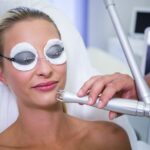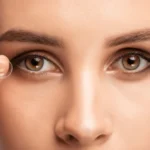Introduction:
Sunglasses are far more than a stylish accessory. They are a vital tool for year-round eye protection, shielding your eyes from harmful UV rays, reducing glare and preventing long-term damage such as cataracts or macular degeneration. Whether you are heading to the beach in summer, walking on snowy winter streets or driving on a sunny day, knowing how to choose the right sunglasses can protect your eyes and enhance comfort in every season.
In this guide, you will discover how to select the best sunglasses for eye protection, identify the perfect frame for your face shape and choose the right lenses for driving, sensitive eyes or everyday wear.
Why Right Sunglasses Are Essential Year-Round?
Many people associate sunglasses with summer but UV radiation is present every day, even during cloudy or cold weather. Sno, sand and water can reflect UV rays, increasing exposure. Prolonged UV damage can lead to
- Cataracts – Clouding of the eye’s lens that blurs vision.
- Macular degeneration – Damage to the retina, affecting central vision.
- Photokeratitis – A painful “sunburn” of the eye.
- Premature aging around the eyes – Fine lines and wrinkles from squinting.
Choosing the best sunglasses for eye protection ensures your eyes remain healthy all year, not just during beach vacations.

Key Features to Look for in Sunglasses
When shopping for sunglasses, keep these features in mind to ensure maximum protection and comfort:
- 100% UV Protection
The most critical feature is a label stating 100% UVA/UVB protection or UV400. This ensures the lenses block harmful rays that can damage your eyes.
- Lens Quality
High-quality lenses reduce distortion and improve visual clarity. Look for lenses that are free from visible defects when held up to the light.
- Polarization
Polarized lenses reduce glare from water, snow or roads, ideal for driving, boating or skiing. While polarization does not affect UV protection directly, it greatly improves comfort.
- Lens Color
The best sunglass lens color for driving is usually gray, brown or amber which maintains true color balance while enhancing contrast. Yellow or rose lenses are great for low-light conditions.
- Fit and Coverage
Choose wraparound styles or oversized frames to protect against UV rays entering from the sides.
Choosing Right Sunglasses by Face Shape
Finding the right frame is not only about style, it also affects comfort and coverage. Here is how to match sunglasses to your unique face shape.
Round Face
If you have a round face, your goal is to add definition and length.
- Best sunglasses shape for a round face – Square, rectangular or angular frames.
- Best sunglass shape for round face – Oversized wayfarers or aviators.
- Sunglass shape for round face – Geometric frames that create contrast.
Oval Face
People with oval faces are lucky because most shapes work well.
- Sunglasses for oval face shape women – Cat-eye, round, aviator and oversized frames.
- Choose frames that are slightly wider than the widest part of your face.
Heart-Shaped Face
A heart-shaped face features a wider forehead and a narrower chin.
- Sunglasses for heart shaped face – Cat-eye or aviator styles that balance the proportions.
- Rimless or light-colored frames soften the look.
Square Face
For strong jawlines and broad foreheads, round or oval frames help soften angles.
- Try aviators, round lenses or curved styles.
Oblong or Rectangular Face
Choose oversized, tall frames to make the face appear shorter. Wraparound sunglasses can also work well.
Sunglasses for Each Face Shape
Ultimately, comfort is key. Try several pairs and note how each fits across the bridge of your nose, rests on your ears and aligns with your cheeks.
Sunglasses for Sensitive Eyes
People with light-colored eyes or eye conditions like photophobia may require extra protection.
- Best sunglasses for sensitive eyes – Choose polarized lenses with UV400 protection and dark tints like gray or brown.
- Wraparound frames help block peripheral light and wind.
- Consider gradient lenses for outdoor-to-indoor transitions.
Seasonal Tips for Sunglass Use
Summer
- Choose polarized lenses to reduce glare from water or sand.
- Opt for sweat-resistant coatings if you spend time outdoors.
Winter
- Snow reflects up to 80% of UV rays. Wear sunglasses or ski goggles with strong UV protection.
- Dark gray or brown lenses enhance contrast against snow.
Driving
- For daytime driving, the best sunglass lens color for driving is gray or amber to maintain natural color perception.
- Polarized lenses reduce glare from wet roads.
Sports and Outdoor Activities
- Choose lightweight, impact-resistant frames.
- Wraparound styles protect from wind and debris.
Maintenance Tips for Long-Lasting Sunglasses
- Always store sunglasses in a protective case.
- Clean lenses with a microfiber cloth to avoid scratches.
- Avoid placing them face down on surfaces.
- Rinse lenses with lukewarm water to remove dust before wiping.
Why Choose LeeVision for Expert Eye Care
While finding the perfect sunglasses is important, regular eye checkups ensure your vision stays healthy for years to come.
LeeVision provides:
- Comprehensive eye exams to detect issues early.
- Personalized recommendations for prescription or non-prescription sunglasses.
- Latest lens technology for UV protection, polarization and blue-light filtering.
- Expert guidance on choosing frames that fit your lifestyle and face shape.
LeeVision’s specialists can evaluate your unique needs, whether you need sunglasses for sensitive eyes, custom prescription lenses or advice on the best sunglass lens color for driving.
Frequently Asked Questions
- Why is UV protection important in sunglasses?
UV rays can cause long-term eye damage such as cataracts, macular degeneration and photokeratitis. Always look for UV400 protection. - Are polarized sunglasses necessary?
Polarized lenses reduce glare which is especially helpful for driving, boating and outdoor activities. - What is the best sunglass lens color for driving?
Gray or brown lenses are best because they maintain natural color balance and reduce glare. - How do I know if my sunglasses block UV rays?
Check the label for 100% UVA/UVB protection or UV400 certification. - Which sunglasses are best for a round face?
Angular frames like square, rectangular or oversized wayfarers complement round faces. - Can right sunglasses help with sensitive eyes?
Yes, polarized lenses with dark tints and wraparound frames provide extra protection for sensitive eyes. - Do expensive sunglasses provide better protection?
Not always. Affordable sunglasses can be just as effective if they provide 100% UV protection. - Are gradient lenses good for eye protection?
Gradient lenses protect against overhead sunlight while allowing better visibility when looking downward. - Should I wear sunglasses in winter?
Yes. Snow reflects UV rays which can be even more damaging than summer sunlight. - How often should I replace my sunglasses?
Replace them if the lenses become scratched or if UV protection wears off, typically every two years.
Conclusion:
Learning how to choose the right sunglasses goes beyond fashion, it is about preserving your eye health for life. By selecting frames that complement your face shape and lenses that provide 100% UV protection, you can enjoy clearer, safer vision in every season. Whether you are seeking the right sunglasses for eye protection, sunglasses for sensitive eyes or simply the best sunglass lens color for driving, making an informed decision is key.
For expert advice, professional fittings and cutting-edge eye care, visit LeeVision. Their specialists will help you find stylish sunglasses that protect your eyes year-round so, you can see the world safely and beautifully.














